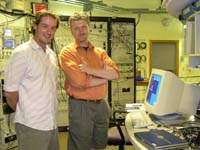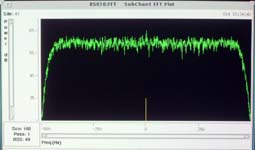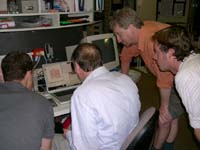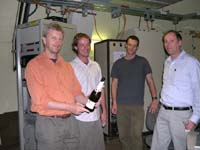14 January 2005
Parkes confirms the Huygens landing
Click on images to see the full-size versions
The CSIRO Parkes Telescope was one of only two telescopes in the world that was capable of receiving the Huygens probe's signal in real-time. Titan rose at Parkes at 11:29 pm (AEDT) which was just 4 minutes before the scheduled landing time of 11:33 pm (AEDT). However, in reality the probe didn't land until 11:46 pm (AEDT). Parkes was able to confirm the safe landing of the probe. This was a second Moon landing for Parkes. The European Space Agency (ESA) subsequently announced to the world that Huygens was safely on the surface of Titan. The signal was considerably stronger than expected - about 4dB or 2.5 times stronger. It was an amazing experience to be the first to "see" the winds of Titan as indicated by the variations in the Doppler shift of the probe's carrier signal as it descended to the surface.
Dion Lewis and Dr John Reynolds, Officer-in-Charge of the CSIRO Parkes Observatory, start the Huygens track. It's a thumbs up from John and all is going well.
The Huygens carrier signal is detected in real-time via the Radio Science Receiver (the small spike in the centre of the passband). The signal was stronger than expected.
In addition to the Parkes staff, the team includes Dr Jim Border and Doug Johnston of JPL who are responsible for operating the JPL/NASA equipment installed at Parkes. Here we see the team engrossed in analysing the Doppler Shift of the Huygens carrier signal.
Titan transitted at about 1:00 am on 15 January (AEDT). Below is an image of the Dish tracking it at the time of transit.
The probe was still transmitting when it finally set at Parkes. This was much longer than expected. The team celebrated by popping open the Champagne. It was a job well done.



